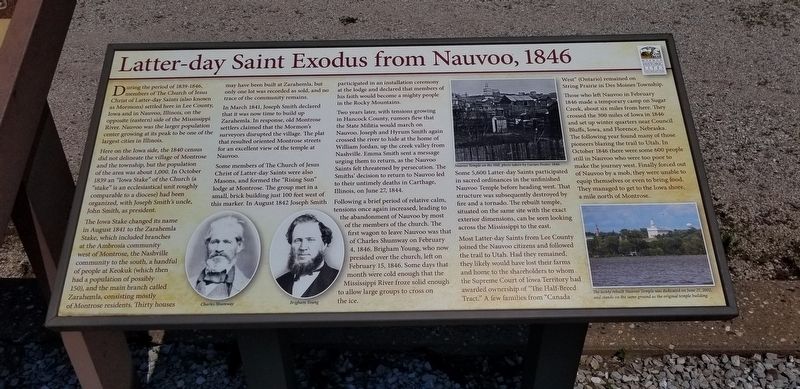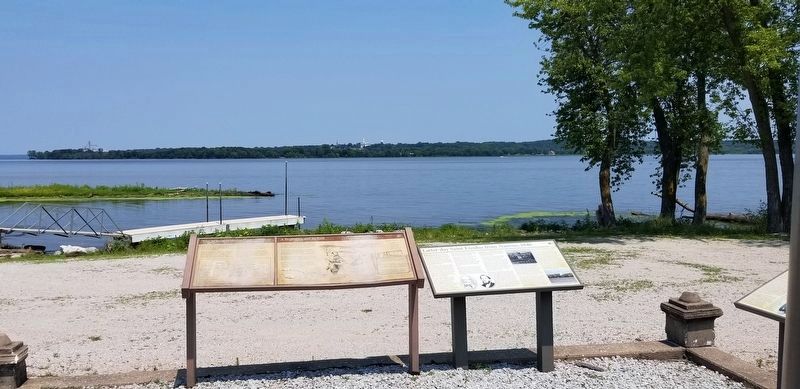Montrose in Lee County, Iowa — The American Midwest (Upper Plains)
Latter-day Saint Exodus from Nauvoo, 1849
During the period of 1839-1846, members of The Church of Jesus Christ of Latter-day Saints (also known as Mormons) settled here in Lee County, Iowa and in Nauvoo, Illinois, on the opposite (eastern) side of the Mississippi River. Nauvoo was the larger population center growing at its peak to be one of the largest cities in Illinois.
Here on the Iowa side, the 1840 census did not delineate the village of Montrose and the township, but the population of the area was about 1,000. In October 1839 an "Iowa Stake" of the Church (a "stake" is an ecclesiastical unit roughly comparable to a diocese) had been organized, with Joseph Smith's uncle, John Smith, as president.
The Iowa Stake changed its name in August 1841 to the Zarahemla Stake, which included branches at the Ambrosia community west of Montrose, the Nashville community to the south, a handful of people at Keokuk (which then had a population of possibly 150), and the main branch called Zarahemla, consisting, mostly of Montrose residents. Thirty houses may have been built at Zarahemla, but only one lot was recorded as sold, and no trace of the community remains.
In March 1841, Joseph Smith declared that it was now time to build up Zarahemla. In response, old Montrose settlers claimed that the Mormon's surveyors disrupted the village. The plat that resulted oriented Montrose streets for an excellent view of the temple at Nauvoo.
Some members of The Church of Jesus Christ of Latter-day Saints were also Masons, and formed the "Rising Sun" lodge at Montrose. The group met in a small, brick building just 100 feet west of this marker. In August 1842 Joseph Smith participated in an installation ceremony at the lodge and declared that members of his faith would become a mighty people in the Rocky Mountains.
Two years later, with tensions growing in Hancock County, rumors flew that the State Militia would march on Nauvoo. Joseph and Hyrum Smith again crossed the river to hide at the home of William Jordan, up the creek valley from Nashville. Emma Smith sent a message urging them to return, as the Nauvoo Saints felt threatened by persecution. The Smiths' decision to return to Nauvoo led to their untimely deaths in Carthage, Illinois, on June 27, 1844.
Following a brief period of relative calm, tensions once again increased, leading to the abandonment of Nauvoo by most of the members of the church. The first wagon to leave Nauvoo was that of Charles Shumway on February 4, 1846. Brigham Young, who now presided over the church, left on February 15, 1846. Some days that pr month were cold enough that the Mississippi River froze solid enough to allow large groups to cross on the ice.
Some 5,600 Latter-day Saints participated in sacred
ordinances in the unfinished Nauvoo Temple before heading west. That structure was subsequently destroyed by fire and a tornado. The rebuilt temple, situated on the same site with the exact exterior dimensions, can be seen looking across the Mississippi to the east.
Most Latter-day Saints from Lee County joined the Nauvoo citizens and followed the trail to Utah. Had they remained, they likely would have lost their farms and home to the shareholders to whom the Supreme Court of Iowa Territory had awarded ownership of The Half-Breed Tract." A few families from "Canada West" (Ontario) remained on String Prairie in Des Moines Township.
Those who left Nauvoo in February 1846 made a temporary camp on Sugar Creek, about six miles from here. They crossed the 300 miles of Iowa in 1846 and set up winter quarters near Council Bluffs, Iowa, and Florence, Nebraska. The following year found many of those pioneers blazing the trail to Utah. In October 1846 there were some 600 people still in Nauvoo who were too poor to make the journey west. Finally forced out of Nauvoo by a mob, they were unable to equip themselves or even to bring food. They managed to get to the Iowa shore, a mile north of Montrose.
Erected by Mormon Historic Sites Foundation.
Topics. This historical marker is listed in this topic list: Churches & Religion.
Location. 40° 31.965′ N, 91° 24.823′ W. Marker is in Montrose, Iowa, in Lee County. Marker is on Main Street east of Water Avenue, on the right when traveling east. Touch for map. Marker is in this post office area: Montrose IA 52639, United States of America. Touch for directions.
Other nearby markers. At least 8 other markers are within one mile of this marker, measured as the crow flies. Fort Des Moines, 1834-1837 (here, next to this marker); The First Fort Des Moines (within shouting distance of this marker); Here Began the Dragoon Trail (about 400 feet away, measured in a direct line); First Orchard In Iowa (approx. 0.3 miles away); Into the Unknown (approx. one mile away in Illinois); Eyes Westward (approx. one mile away in Illinois); Exodus to Greatness (approx. one mile away in Illinois); Aquatic Life of Mississippi River Pool 19 (approx. one mile away in Illinois). Touch for a list and map of all markers in Montrose.
More about this marker. Located in the Riverview Park, at the terminus of Main Street at Water Avenue.
Credits. This page was last revised on August 15, 2021. It was originally submitted on August 15, 2021, by Cajun Scrambler of Assumption, Louisiana. This page has been viewed 183 times since then and 18 times this year. Photos: 1, 2. submitted on August 15, 2021, by Cajun Scrambler of Assumption, Louisiana.

